2014 年 6 月英语六级真题(三)
Part I
Directions: Forthispart,youareallowed30minutestowriteanessayexplainingwhyitisunwise
to put all your eggs in one basket. You can give examples to illustrate your point.
You should write at least 150 words but no more than 200 words.
(30 minutes)
Writing
Part II
说明:2014 年 6 月六级真题全国共考了两套听力。本套(即第三套)的听力内容与第二套的完全一样,只
是选项的顺序不一样而已,故在本套中不再重复给出。
Listening Comprehension
(30 minutes)
Reading
(40 minutes)
Comprehension
Part III
Section A
Directions: In this section,there is a passage with tenblanks. You are required to select one
wordforeachblankfromalistofchoicesgiveninawordbankfollowingthepassage.
Readthepassagethroughcarefullybeforemakingyourchoices.Eachchoiceinthebank
isidentifiedbyaletter.PleasemarkthecorrespondingletterforeachitemonAnswer
Sheet2withasinglelinethroughthecentre.Youmaynotuseanyofthewordsinthe
bank more than once.
Questions 36 to 45 are based on the following passage.
Millions of Americans are entering their 60s and are more concerned than ever about retirement.
They know they need to save, but how much? And what exactly are they saving for—to spend more
time
the grandkids, go traveling, or start another career? It turns out that husbands
and wives may have
different ideas about, the subject.
36
37
The deepest divide is in the way spouses envisage their lifestyle in their later years. Fidelity
Investments Inc. found 41 percent of the 500 couples it surveyed
on whether both or at
least one spouse will work in retirement. Wives are generally right regarding their husbands’
retirement age, but men
the age their wives will be when they stop working. And husbands
are slightly more
40
39
about their standard of living than wives are.
38
Busy juggling (穷于应付) careers and families, most couples don’t take the time to sit down,
42
or together, and think about what they would like to do 5,10 or 20 years from now. They
41
they are on the same page, but the
43
is they have avoided even talking about it.
If you are self-employed or in a job that doesn’t have a standard retirement age, you may
be more apt to delay thinking about these issues. It is often a
retirement date that
provides the catalyst (催化剂) to start planning. Getting laid off or accepting an early-retirement
45
can force your hand. But don’t wait until you get a severance (遣散费) check to begin
planning.
注意:此部分试题请在答题卡 2 上作答。
44
�
A) assume
B) confidential
C) disagree
D) formula
E) forthcoming
F) illustrating
G) mysteriously
H) observe
I) optimistic
J) package
K) radically
L) reality
M) separately
N) spoiling
O) underestimate
Section B
Directions: Inthissection,youaregoingtoreadapassagewithtenstatementsattachedtoit.
Each statement contains information given in one of the paragraphs. Identify the
paragraphfromwhichtheinformationisderived. Youmaychooseaparagraphmorethan
once. Each paragraph is marked with a letter. Answer the questions by marking the
corresponding letter on Answer Sheet 2.
What If Middle-Class Jobs Disappear?
A) The most recent recession in the United States began in December 2007 and ended in June 2009,
according to the National Bureau of Economic Research. However, two years after the official end
of the recession, few Americans would say that economic troubles are behind us. The unemployment
rate, in particular, remains above 9%. Some labor market indicators, such as the proportion of
long-term unemployed, are worse now than for any postwar recession.
B) There are two widely circulated narratives to explain what’s going on. The Keynesian narrative
is that there has been a major drop in aggregate demand. According to this narrative, the slump
can be largely cured by using monetary and fiscal (财政的) stimulus. The main anti-Keynesian
narrative is that businesses are suffering from uncertainty and over-regulation. According to
this narrative, the slump can be cured by having the government commit to and follow a more hands-off
approach.
C) I want to suggest a third interpretation. Without ruling out a role for aggregate demand or
for the regulatory environment, I wish to suggest that structural change is an important factor
in the current rate of high unemployment. The economy is in a state of transition, in which the
middle-class jobs that emerged after World War II have begun to decline. As Erik Brynjolfsson
and Andrew McAfee put it in a recent e-book Race Against the Machine : “The root of our problems
is not that we’re in a great recession, or a great stagnation (停滞), but rather that we are
in the early throes (阵痛) of a great restructuring.”
D) In fact, I believe the Great Depression of the 1930s can also be interpreted in part as an
economic transition. The impact of the internal combustion engine (内燃机) and the small electric
motor on farming and manufacturing reduced the value of uneducated laborers. Instead, by the 1950s,
a middle class of largely clerical (从事文秘工作的) workers was the most significant part of the
labor force.
�
Between 1930 and 1950, the United States economy underwent a great transition. Demand fell
for human effort such as lifting, squeezing, and hammering. Demand increased for workers who could
read and follow directions. The evolutionary process eventually changed us from a nation of
laborers to a nation of clerks.
E) The proportion of employment classified as “clerical workers” grew from 5.2% in 1910 to a
peak of 19.3% in 1980. (However, by 2000 this proportion had edged down to 17.4%.) Overall, workers
classified as clerical workers, technical workers, managers and officials exceeded 50% of the
labor force by 2000. Corresponding declines took place in the manual occupations. Workers
classified as laborers, other than farm hands or miners, peaked at 11.4% of the labor force in
1920 but were barely 6% by 1950 and less than 4% by 2000. Farmers and farm laborers fell from
33% of the labor force in 1910 to less than 15% by 1950 and only 1.2% in 2000.
F) The introduction of the tractor and improvements in the factory rapidly reduced the demand
for uneducated workers. By the 1930s, a marginal farm hand could not produce enough to justify
his employment. Sharecropping, never much better than a subsistence occupation, was no longer
viable (可行的). Meanwhile, machines were replacing manufacturing occupations like cigar rolling
and glass blowing for light bulbs.
G) The structural-transition interpretation of the unemployment problem of the 1930s would be
that the demand for uneducated workers in the United States had fallen, but the supply remained
high. The high school graduation rate was only 8.8% in 1912 and still just 29% in 1931. By 1950,
it had reached 59%. With a new generation of workers who had completed high school, the mismatch
between skills and jobs had been greatly reduced.
H) What took place after World War II was not the revival of a 1920s economy, with its small farming
units, urban manufacturing, and plurality of laborers. Instead, the 1950s saw the creation of
a new suburban economy, with a plurality of white-collar workers. With an expanded transportation
and communications infrastructure (基础设施), businesses needed telephone operators, shipping
clerks and similar occupations. If you could read, follow simple instructions, and settle into
a routine, you could find a job in the post-war economy.
I) The trend away from manual labor has continued. Even within the manufacturing sector, the share
of production and non-supervisory workers in manufacturing employment went from over 85% just
after World War [I to less than 70% in more recent years. To put this another way, the proportion
of white-collar work in manufacturing has doubled over the past 50 years. On the factory floor
itself, work has become less physically demanding. Instead, it requires more cognitive skills
and the ability to understand and carry out well-defined procedures.
J) As noted earlier, the proportion of clerical workers in the economy peaked in 1980. By that
date, computers and advanced communications equipment had already begun to affect telephone
operations and banking. The rise of the personal computer, and the Internet has widened the impact
of these technologies to include nearly every business and industry.
�
K) The economy today differs from that of a generation ago. Mortgage and consumer loan underwriters
(风险评估人) have been replaced by credit scoring. Record stores have been replaced by music
downloads. Book stores are closing, while sales of books on electronic readers have increased.
Data entry has been moved off shore. Routine customer support also has been outsourced (外包)
overseas.
L) These trends serve to limit the availability of well-defined jobs. If a job can be characterized
by a precise set of instructions, then that job is a candidate to be automated or outsourced to
modestly educated workers in developing countries. The result is what David Autor calls the
polarization of the American job market.
M) Using the latest Census Bureau data, Matthew Slaughter found that from 2000 to 2010 the real
earnings of college graduates (with no advanced degree) fell by more in percentage terms than
the earnings of high school graduates. In fact, over this period the only education category to
show an increase in earnings was those with advanced degrees.
N) The outlook for mid-skill jobs would not appear to be bright. Communications technology and
computer intelligence continue to improve, putting more occupations at risk. For example, many
people earn a living as drivers, including trucks and taxicabs. However, the age of driverless
vehicles appears to be moving closer. Another example is in the field of education. In the fall
of 2011, an experiment with an online course in artificial intelligence conducted by two Stanford
professors drew tens of thousands of registrants (报名者). This increases the student-teacher
ratio by a factor of close to a thousand. Imagine the number of teaching jobs that might be
eliminated if this could be done for math, economics, chemistry, and so on.
O) It’s important to bear in mind that when we offer a structural interpretation of unemployment,
a “loss of jobs” means an increase in productivity. Traditionally, economists have argued that
productivity increases are a good thing, even though they may cause unemployment for some workers
in the short run. In the long run, the economy does not run out .of jobs. Rather, new jobs emerge
as old jobs disappear. The story we tell is that average well-being rises, and the more people
are able to adapt, the more widespread the improvement becomes.
46. Even factory floor work today has become intellectually challenging rather than physically
demanding.
47. Increases in productivity prove beneficial though some people may lose their jobs temporarily.
48. The unemployment rate remained high even two years after the government declared the recent
recession was over.
49. The author suggests that the recent high unemployment rate is mainly caused by a decrease
of middleclass jobs.
50. The creation of a suburban economy in the 1950s created lots of office jobs.
51. In the first decade of the 21st century, only people with postgraduate degrees experienced
an increase in earnings.
52. One economics theory suggests using monetary and fiscal stimulus to cope with an economic
recession.
�
53. The popularity of online courses may eliminate many teaching jobs.
54. Computer technology has brought about revolutionary changes in the record and book business.
55. White-collar workers accounted for more than half of the labor force by the end of the 20th
century.
Section C
Directions: There are2 passagesin this section.Eachpassage isfollowedby somequestions or
unfinished statements. For each of them there are four choices marked A), B), C) and
D). You should decide on the best choice and mark the corresponding letter on Answer
Sheet 2 with a single line through the centre.
Passage One
Questions 56 to 60 are based on the following passage.
“Deep reading”—as opposed to the often superficial reading we do on the Web—is an
endangered practice, one we ought to take steps to preserve as we would a historic building or
a significant work of art. Its disappearance would jeopardize the intellectual and emotional
development of generations growing up online, as well as the preservation of a critical part of
our culture: the novels, poems and other kinds of literature that can be appreciated only by readers
whose brains, quite literally, have been trained to understand them.
Recent research in cognitive science and psychology has demonstrated that deep reading—slow,
immersive, rich in sensory detail and emotional and moral complexity—is a distinctive experience,
different in kind from the mere decoding of words. Although deep reading does not, strictly speaking,
require a conventional book, the built-in limits of the printed page are uniquely helpful to the
deep reading experience. A book’s lack of hyperlinks (超链接), for example, frees the reader
from making decisions—Should I click on this link or not?—allowing her to remain fully immersed
in the narrative.
That immersion is supported by the way the brain handles language rich in detail, indirect
reference and figures of speech: by creating a mental representation that draws on the same brain
regions that would be active if the scene were unfolding in real life. The emotional situations
and moral dilemmas that are the stuff of literature are also vigorous exercise for the brain,
propelling us inside the heads of fictional characters and even, studies suggest, increasing our
real-life capacity for empathy (认同).
None of this is likely to happen when we’re browsing through a website. Although we call
the activity by the same name, the deep reading of books and the information-driven reading, we
do on the Web are very different, both in the experience they produce and in the capacities they
develop. A growing body of evidence suggests that online reading may be less engaging and less
satisfying, even for the “digital natives” to whom it is so familiar. Last month, for example,
Britain’s National Literacy Trust released the results of a study of 34,910 young people aged
8 to 16. Researchers reported that 39% of children and teens read daily using electronic devices,
but only 28% read printed materials every day. Those who read only onscreen were three times less
likely to say they enjoy reading very much and a third less likely to have a favorite book. The
study also found that young people who read daily only onscreen were nearly two times less likely
to be above-average readers than those who read daily in print or both in print and onscreen.
注意;此部分试题请在答题卡 2 上作答。
�
56. What does the author say about “deep reading”?
A. It serves as a complement to online reading.
B. It should be preserved before it is too late.
C. It is mainly suitable for reading literature.
D. It is an indispensable part of education.
57. Why does the author advocate the reading of literature?
A. It helps promote readers’ intellectual and emotional growth.
B. It enables readers to appreciate the complexity of language.
C. It helps readers build up immersive reading habits.
D. It is quickly becoming an endangered practice.
58. In what way does printed-page reading differ from online reading?
A. It ensures the reader’s cognitive growth.
B. It enables the reader to be fully engaged.
C. It activates a different region of the brain.
D. It helps the reader learn rhetorical devices.
59. What do the studies show about online reading?
A. It gradually impairs one’s eyesight.
B. It keeps arousing readers’ curiosity.
C. It provides up-to-date information.
D. It renders reading less enjoyable.
60. What do we learn from the study released by Britain’s National Literacy Trust?
A. Onscreen readers may be less competent readers.
B. Those who do reading in print are less informed.
C. Young people find reading onscreen more enjoyable.
D. It is now easier to find a favorite book online to read.
Passage Two
Questions 61 to 65 are based on the following passage.
Many current discussions of immigration issues talk about immigrants in general, as if they
were abstract people in an abstract world. But the concrete differences between immigrants from
different countries affect whether their coming here is good or bad for the American people.
The very thought of formulating immigration laws from the standpoint of what is best for the
American people seems to have been forgotten by many who focus on how to solve the problems of
illegally immigration.
It is hard to look for “the ideal outcome” on immigration in the abstract. Economics professor
Milton Friedman once said, “The best is the enemy of the good,” which to me meant that attempts
to achieve an unattainable ideal can prevent us from reaching good outcomes that are possible
in practice.
Too much of our current immigration controversy is conducted in terms of abstract ideals,
such as “We are a nation of immigrants.” Of course we are a nation of immigrants. But we are
also a nation of people who wear shoes. Does it follow that we should admit anybody who wears
shoes?
The immigrants of today are very different from those who arrived here a hundred years ago.
Moreover, the society in which they arrive is different. To me, it is better to build a wall around
�
the welfare state than the country.
But the welfare state is already here--and, far from having a wall built around it, the welfare
state is expanding in all directions. We do not have a choice between the welfare state and open
borders. Anything we try to do as regards immigration laws has to be done in the context of a
huge welfare state that is already a major, inescapable fact of life.
Among other facts of life utterly ignored by many advocates of de facto amnesty (事实上的
大赦) is that the free international movement of people is different from free international trade
in goods.
Buying cars or cameras from other countries is not the same as admitting people from those
countries or any other countries. Unlike inanimate objects, people have cultures and not all
cultures are compatible with the culture in this country that has produced such benefits for the
American people for so long.
Not only the United States, but the Western world in general, has been discovering the hard
way that admitting people with incompatible cultures is an irreversible decision with incalculable
consequences. If we do not see that after recent terrorist attacks on the streets of Boston and
London, when will we see it?
“Comprehensive immigration reform” means doing everything all together in a rush, without
time to look before we leap, and basing ourselves on abstract notions about abstract people.
61. What does the author say about immigrants in America?
A)They all hope to gain citizenship and enjoy the welfare.
B)They come to America with different dreams and purposes.
C)Their background may determine whether they benefit the American people.
D)Their cultures affect the extent to which they will achieve success in America.
62. What does the author try to say by citing Milton Friedman’s remark?
A)It is hardly practical to find an ideal solution to America’s immigration problem.
B)Ideal outcomes could be produced only by comprehensive immigration reform.
C)As for immigration, good results cannot be achieved without good intentions.
D)The proper solution of immigration issues is an ideal of the American public.
63. What is the author’s view regarding America’s immigration policy?
A)America should open its borders to immigrants from different countries.
B)Immigrants have contributed greatly to the welfare of American people.
C)Unrestricted immigration will undermine the American welfare state.
D)There is no point building a wall around the American welfare state.
64. What is the author’s purpose in citing the recent terrorist attacks on the streets of Boston
and London?
A)To show that America should join hands with Europe in fighting terrorists.
B)To prove that it is high time America made comprehensive immigration reforms.
C)To prove that terrorism is the most dangerous threat to America and the world in general.
D)To show that immigrants’ cultural incompatibility with the host country has consequences.
65. What is the author’s attitude towards “comprehensive immigration reform”?
A)Supportive.
B)Negative.
C)Wait-and-see.
�
D)Indifferent.
Part IV
Directions: For this part, you are allowed 30 minutes to translate a passage from Chinese into
(30 minutes)
Translation
English. You should write your answer on Answer Sheet 2.
最近,中国科学院(Chinese Academy of Sciences)出版了关于其最新科学发现与未来一年展望的年度
系列报告。系列报告包括三部分:科学发展报告、高技术发展报告、中国可持续发展战略报告。第一份报
告包含中国科学家的最新发现,诸如新粒子研究与 H7N9 病毒研究的突破。该报告还突出强调了未来几年需
要关注的问题。第二份报告公布了一些应用科学研究的热门领域,如 3D 打印和人造器官研究。第三份报告
呼吁加强顸层设计,以消除工业升级中的结构性障碍,并促进节能减排。
注意:此部分试题请在答题卡 2 上作答。
�
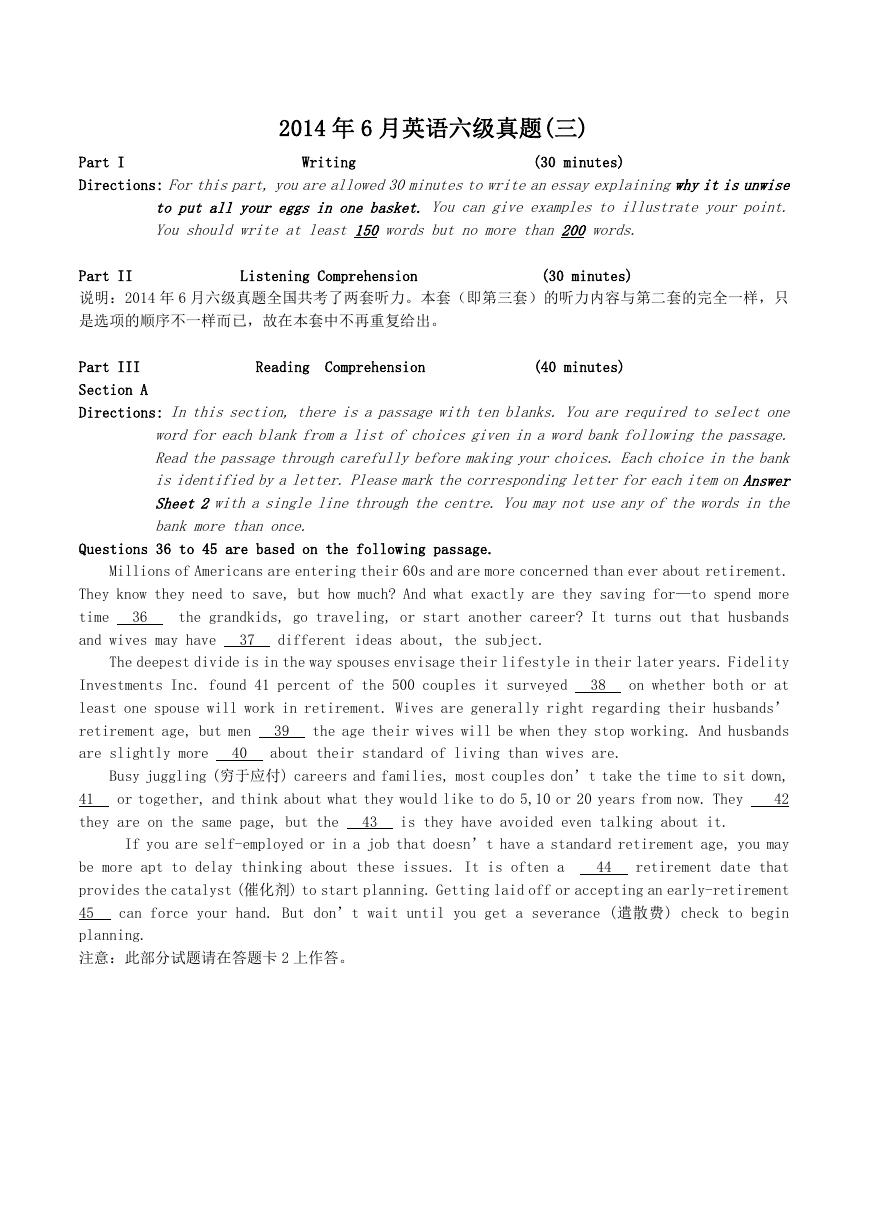
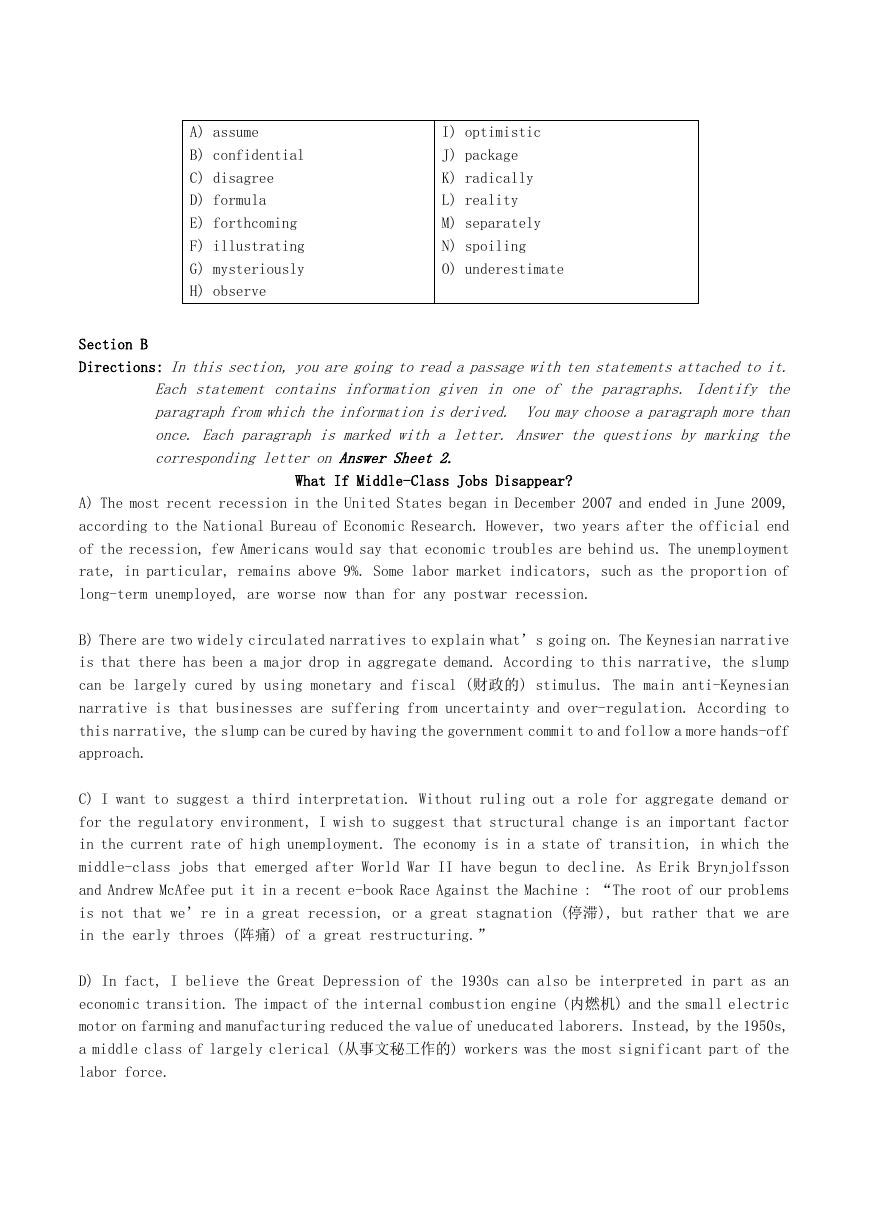
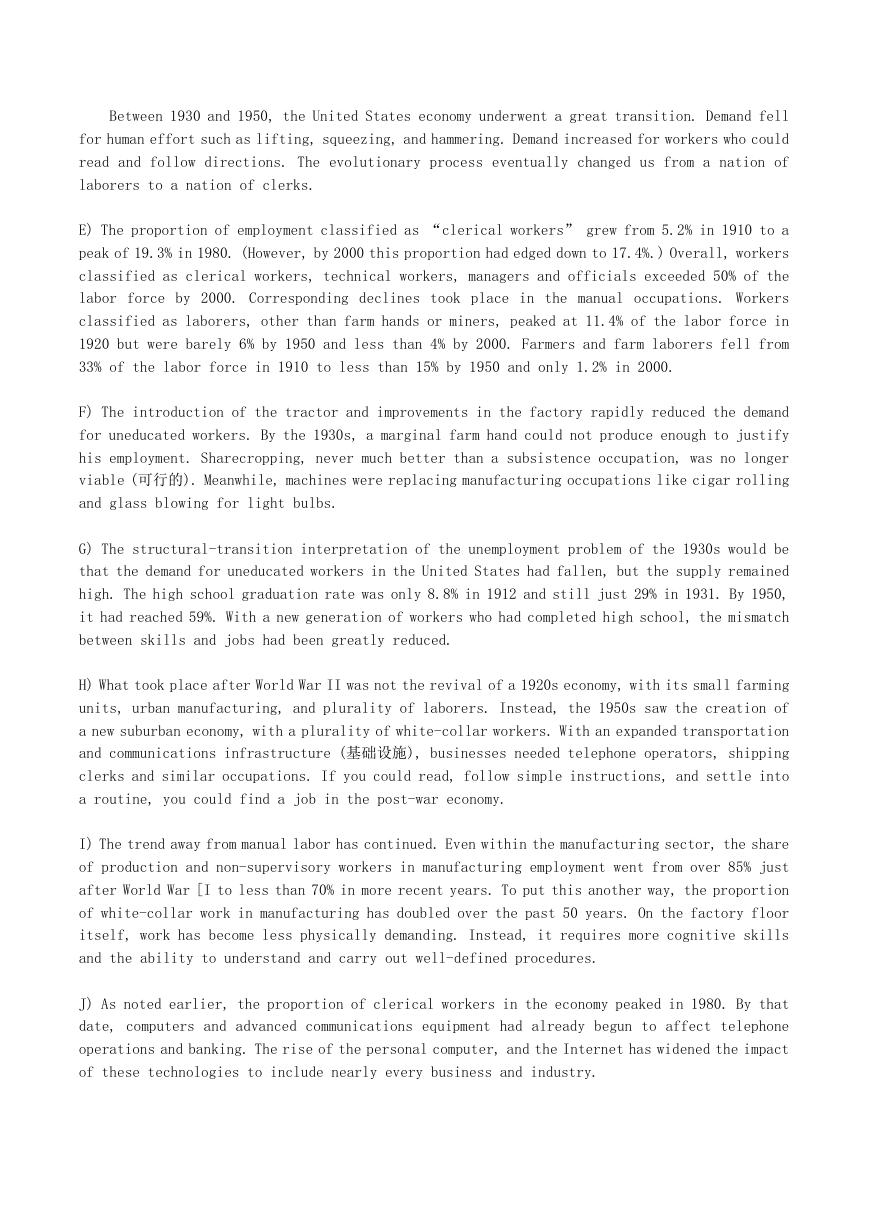
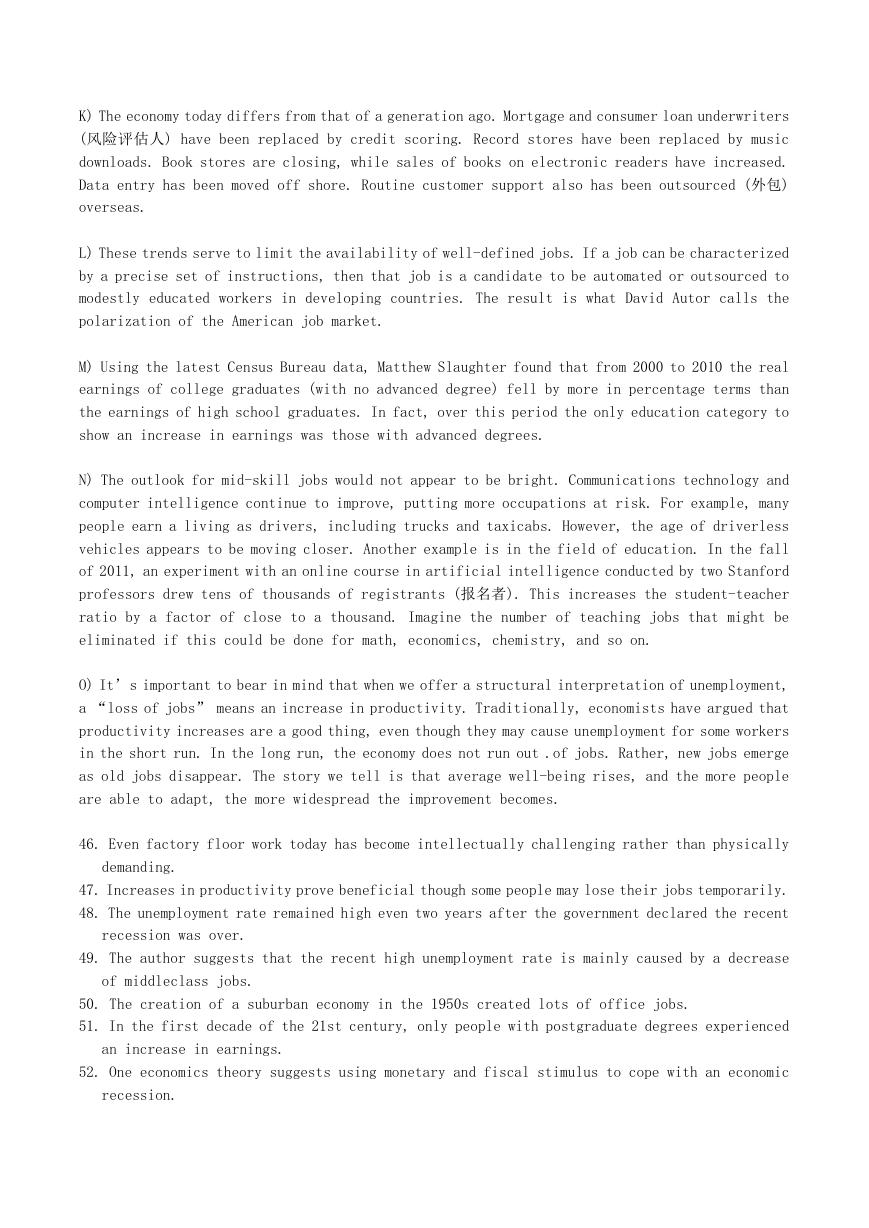
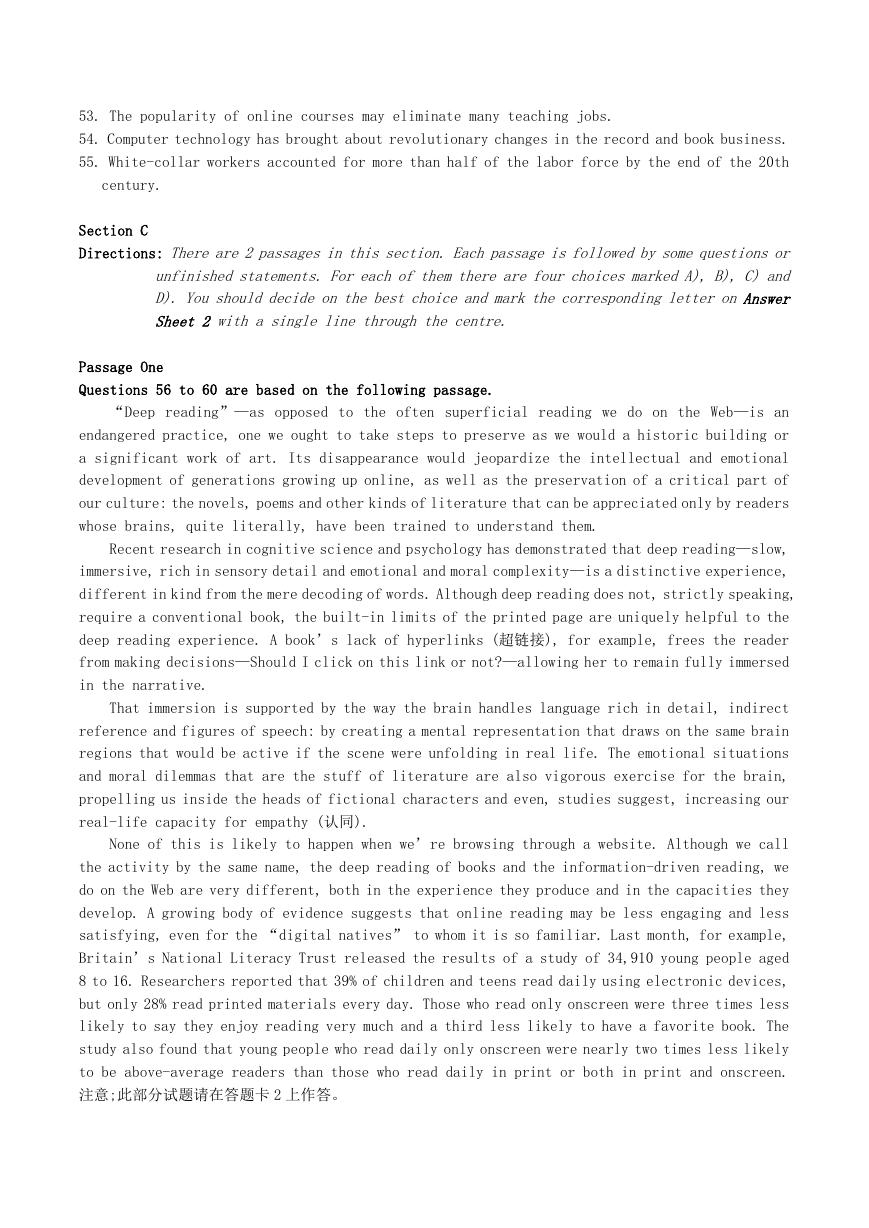
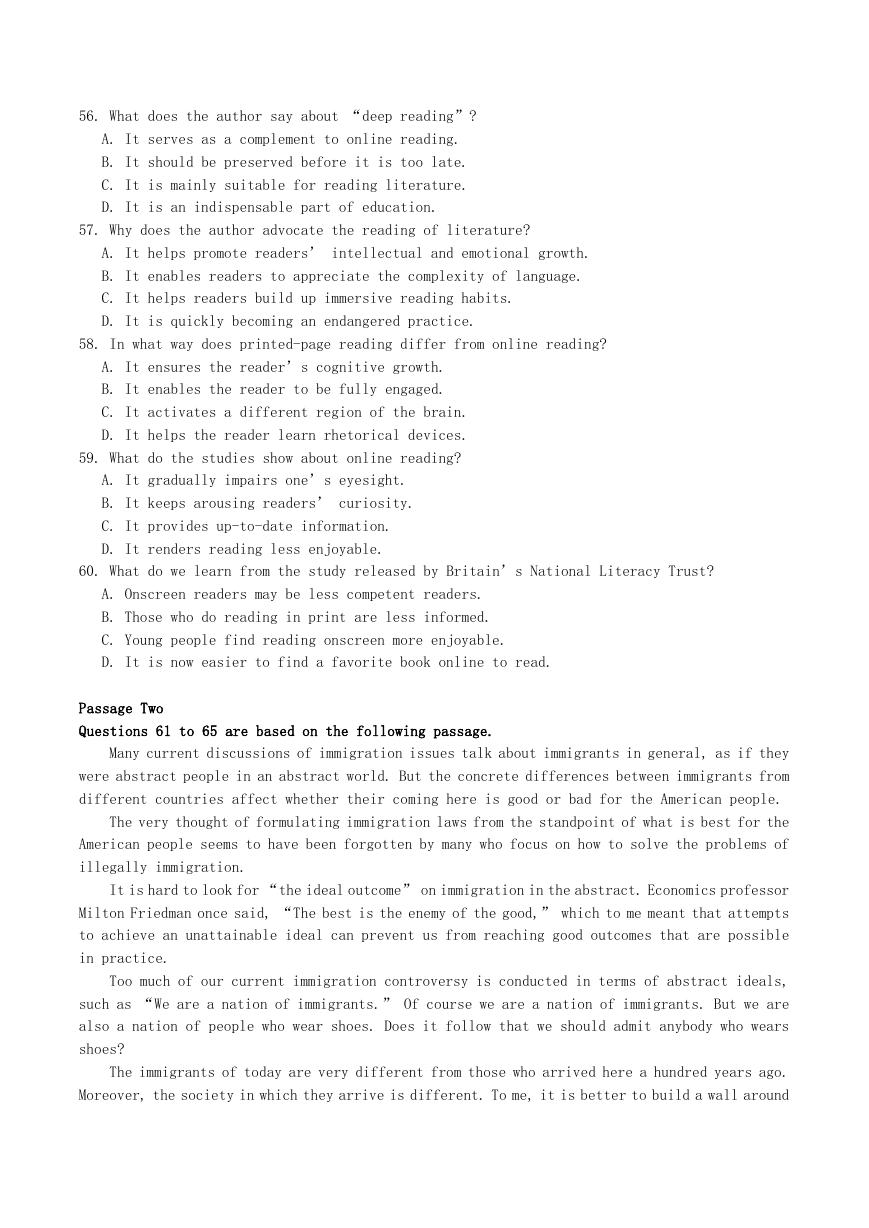

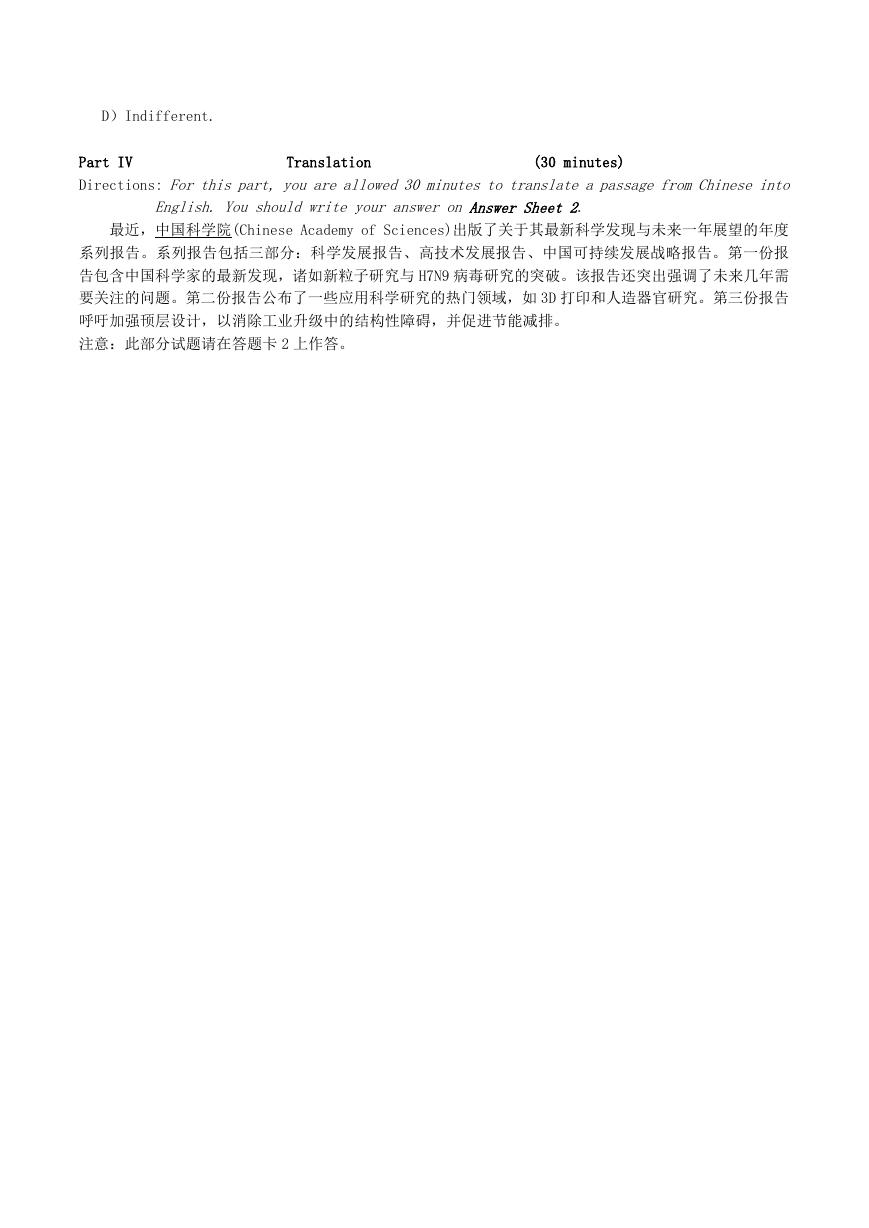








 2023年江西萍乡中考道德与法治真题及答案.doc
2023年江西萍乡中考道德与法治真题及答案.doc 2012年重庆南川中考生物真题及答案.doc
2012年重庆南川中考生物真题及答案.doc 2013年江西师范大学地理学综合及文艺理论基础考研真题.doc
2013年江西师范大学地理学综合及文艺理论基础考研真题.doc 2020年四川甘孜小升初语文真题及答案I卷.doc
2020年四川甘孜小升初语文真题及答案I卷.doc 2020年注册岩土工程师专业基础考试真题及答案.doc
2020年注册岩土工程师专业基础考试真题及答案.doc 2023-2024学年福建省厦门市九年级上学期数学月考试题及答案.doc
2023-2024学年福建省厦门市九年级上学期数学月考试题及答案.doc 2021-2022学年辽宁省沈阳市大东区九年级上学期语文期末试题及答案.doc
2021-2022学年辽宁省沈阳市大东区九年级上学期语文期末试题及答案.doc 2022-2023学年北京东城区初三第一学期物理期末试卷及答案.doc
2022-2023学年北京东城区初三第一学期物理期末试卷及答案.doc 2018上半年江西教师资格初中地理学科知识与教学能力真题及答案.doc
2018上半年江西教师资格初中地理学科知识与教学能力真题及答案.doc 2012年河北国家公务员申论考试真题及答案-省级.doc
2012年河北国家公务员申论考试真题及答案-省级.doc 2020-2021学年江苏省扬州市江都区邵樊片九年级上学期数学第一次质量检测试题及答案.doc
2020-2021学年江苏省扬州市江都区邵樊片九年级上学期数学第一次质量检测试题及答案.doc 2022下半年黑龙江教师资格证中学综合素质真题及答案.doc
2022下半年黑龙江教师资格证中学综合素质真题及答案.doc